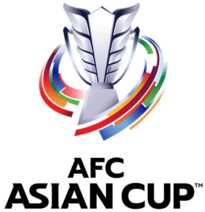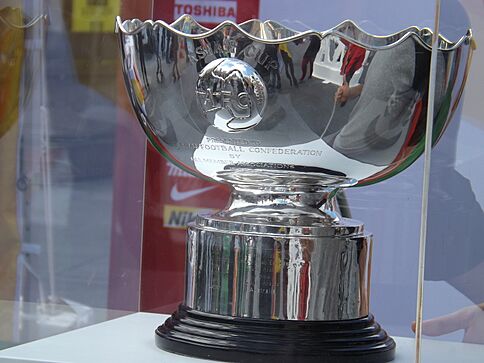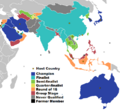AFC Asian Cup facts for kids
 |
|
| Organising body | AFC |
|---|---|
| Founded | 1956 |
| Region | Asia and Australia |
| Number of teams | 24 (finals) 47 (eligible to enter qualification) |
| Current champions | |
| Most successful team(s) | |
The AFC Asian Cup is a major football competition. It is played by the best men's national teams in Asia. The Asian Football Confederation (AFC) organizes this tournament. It decides which country is the champion of Asia. This cup is the second oldest football championship for continents in the world. Only the Copa América is older. The team that wins becomes the champion of Asia. Until 2015, the winner also got to play in the FIFA Confederations Cup.
The Asian Cup happened every four years from 1956 to 2004. In 2004, the AFC changed the schedule. This was because the Summer Olympic Games and the European Football Championship were also in the same year. To avoid busy schedules, the tournament moved. After 2004, the next cup was in 2007. Four countries in Southeast Asia hosted it together. These were Indonesia, Malaysia, Thailand, and Vietnam. Since then, it has been held every four years again.
A few strong teams have often won the Asian Cup. Japan has won four times. Iran and Saudi Arabia have each won three times. South Korea and Qatar have won twice. Other teams that have won include Australia (2015), Iraq (2007), and Kuwait (1980). Israel won in 1964. Israel later left the AFC and joined a different football group, UEFA.
Australia joined the Asian football group in 2007. They hosted the Asian Cup in 2015. Australia won the competition by beating South Korea in the final. From the 2019 tournament onwards, more teams could play. The number of teams grew from 16 to 24. The qualifying games for the Asian Cup also became part of the FIFA World Cup qualification.
Contents
History of the Asian Cup
How it Started
People first thought about a football competition for all of Asia after World War II. But it did not happen until the 1950s. The Asian Football Confederation (AFC) was created in 1954. Two years later, the first AFC Asian Cup took place in British Hong Kong. Seven of the twelve founding members played in it. This made it the second oldest continental competition in the world.
To qualify, teams had to be the hosts or winners from different zones. These zones were Central, Eastern, and Western Asia. The first few tournaments had only four teams. This format was used in 1956, 1960, and 1964. Each smaller football group in Asia already had its own championship.
South Korea was very strong in the early years. They won the championship in both 1956 and 1960. These are still South Korea's best results in the tournament.
West Asian Teams Take Over (1964–1988)
After Hong Kong and South Korea hosted the first two cups, Israel hosted the 1964 AFC Asian Cup. This tournament also had four teams. They played in one group to decide the winner. Israel won the tournament, finishing ahead of India. The format changed to five teams in 1968. Then it grew to six teams in 1972 and 1976.
Iran became very strong during this time. They won three tournaments in a row. These were in 1968, 1972, and 1976. Iran hosted the 1968 and 1976 cups. Iran is the only team in Asia to win three Asian Cups in a row. The 1972 final was special. It was the first Asian Cup to use a group stage followed by knockout games. This format was used in later tournaments too.
From 1980 to 1988, ten teams played in the cup. But teams from West Asia continued to win. Kuwait became the first Arab country to win. They won in 1980 on their home ground. They beat South Korea 3–0 in the final. Saudi Arabia started to become a top team. They won two Asian Cups in a row. These wins were in 1984 and 1988. They beat both China and South Korea. These were Saudi Arabia's first times playing in major competitions.
Japan's Rise and Modern Asian Cup (1992–2011)
Before the 1990s, Japan was not a big name in Asian football. They only played in the 1988 cup, which was their first time in a continental tournament. But as Japan's football became more professional, their luck changed. Japan hosted the 1992 AFC Asian Cup. This cup had eight teams and two groups. Japan won by beating Saudi Arabia, who were the champions at the time, 1–0. This was Japan's first big international win.
The 1996 AFC Asian Cup had twelve teams. This was part of making the tournament more professional. The hosts, UAE, reached the final for the first time. But they lost to Saudi Arabia in a penalty shootout. Saudi Arabia had reached their fourth Asian final in a row. This was Saudi Arabia's third Asian title.
The 2000 AFC Asian Cup was the first time Lebanon played in the tournament. Saudi Arabia again reached the final. But this time, Japan beat Saudi Arabia 1–0. Japan then won their Asian trophy again four years later. This win was harder, and the final against hosts China was very intense. The 2004 cup was important because it had 16 teams. It was also the first time Saudi Arabia did not play in an Asian Cup final.
The 2007 AFC Asian Cup was the first time Australia played. Australia had left the Oceania Football Confederation in 2006. This tournament was also the first football competition hosted by more than two countries. Four countries in Southeast Asia hosted it: Vietnam, Thailand, Malaysia, and Indonesia. In this tournament, Iraq became Asian champions. They beat strong teams like Australia, South Korea, and Saudi Arabia.
Australia, after a tough start in 2007, did much better in the 2011 AFC Asian Cup in Qatar. They reached the final but lost to Japan after extra time. Japan's win meant they had won four titles, making them the most successful team in Asian football. This tournament was also the first Asian Cup to use jersey numbers from 1 to 23.
Expanding the Asian Cup (2015–Present)
After Australia did well in the 2011 Asian Cup, the AFC allowed them to host the 2015 AFC Asian Cup. In this tournament, Australia played very well. They only lost one game, which was against South Korea. Australia then got revenge by beating South Korea 2–1 in the final after extra time. This win was the first Asian title for a team from the Southeast Asia region, as Australia joined the AFF in 2013. The AFC Asian Cup started on January 12, 2024, and ended on February 10, 2024.
At the 2019 AFC Asian Cup, video assistant referees (VAR) were used for the first time. The tournament also grew to 24 teams. Also, a fourth substitute player was allowed during extra time. The United Arab Emirates hosted this tournament for the second time. Qatar won their first Asian title. They beat Japan 3–1 in the final.
How the Tournament Works
Final Tournament Stages
Since 1972, the final tournament has two main parts. These are the group stage and the knockout stage.
Since 2019, 24 teams play in the Asian Cup final tournament. Before that, from 2004 to 2015, there were 16 teams. In the group stage, each team plays three games in a group of four. The top two teams from each group move on to the knockout stage. Four of the best third-placed teams also get to move on. In the knockout stage, the sixteen teams play in a single-elimination style. This means if you lose, you are out. It starts with the round of 16 and ends with the final match.
| Year | Teams | Matches | Format |
|---|---|---|---|
| 1956 | 4 | 6 | round-robin group of 4 |
| 1960 | 4 | 6 | |
| 1964 | 4 | 6 | |
| 1968 | 5 | 10 | round-robin group of 5 |
| 1972 | 6 | 13 | group allocation matches, 2 groups of 3, semi-finals, 3rd-place match, final |
| 1976 | 6 | 10 | 2 groups of 3, semi-finals, 3rd-place match, final |
| 1980 | 10 | 24 | 2 groups of 5, semi-finals, 3rd-place match, final |
| 1984 | 10 | 24 | |
| 1988 | 10 | 24 | |
| 1992 | 8 | 16 | 2 groups of 4, semi-finals, 3rd-place match, final |
| 1996 | 12 | 26 | 3 groups of 4, quarter-finals, semi-finals, 3rd-place match, final |
| 2000 | 12 | 26 | |
| 2004 | 16 | 32 | 4 groups of 4, quarter-finals, semi-finals, 3rd-place match, final |
| 2007 | 16 | 32 | |
| 2011 | 16 | 32 | |
| 2015 | 16 | 32 | |
| 2019 | 24 | 51 | 6 groups of 4, round of 16, quarter-finals, semi-finals, final |
| 2023 | 24 | 51 | |
| 2027 | 24 | 51 | |
| 2031 | 24 | 51 |
The Asian Cup Trophy
There have been two different trophies for the Asian Cup. The first one was used from 1956 to 2015. The second one has been used since 2019.
The first trophy looked like a bowl with a round base. It was 42 centimeters tall and weighed 15 kilograms. Until the 2000 tournament, the black base had plates with the names of every winning country. The trophy was then changed. It had more silver and a thinner black base. This new base did not have plates. Instead, the winning countries' names were carved around the base.
A brand new trophy was shown on May 4, 2018. This happened during the draw for the 2019 group stage. It was made by Thomas Lyte, a company in London. The new trophy is 78 centimeters tall and 42 centimeters wide. It weighs 15 kilograms and is made of silver. A team of 12 people spent over 450 hours making it by hand.
The trophy looks like a lotus flower. The lotus flower is an important plant in Asia. The five petals of the lotus stand for the five smaller football groups under the AFC. The names of the winning countries are carved around the trophy's base. This base can be separated from the main part of the trophy. This new trophy also has a handle on each side, unlike the old one.
Tournament Results
- Key
- aet: result/match won after extra time (played longer than normal time)
- p: match won after penalty shoot-out (teams take turns shooting from the penalty spot)
- TBD: to be determined (not decided yet)
Teams in the Top Four
The first four Asian Cup tournaments had only four or five teams. They played in one group. Since 1972, the final tournament has included a knockout stage. Since 2019, there is no game for third place. From 2023, the AFC ranks the losing semi-finalists. This is based on how many goals they scored in the semi-finals.
Bold text means the team was the host country.
| Team | Champions | Runners-up | Third place | Fourth place | Semi-finalist | Top 4 total |
|---|---|---|---|---|---|---|
| 4 (1992, 2000, 2004, 2011) | 1 (2019) | N/A | 1 (2007) | N/A | 6 | |
| 3 (1984, 1988, 1996) | 3 (1992, 2000, 2007) | N/A | N/A | N/A | 6 | |
| 3 (1968, 1972, 1976) | N/A | 4 (1980, 1988, 1996, 2004) | 1 (1984) | 2 (2019, 2023) | 10 | |
| 2 (1956, 1960) | 4 (1972, 1980, 1988, 2015) | 4 (1964, 2000, 2007, 2011) | N/A | 1 (2023) | 11 | |
| 2 (2019, 2023) | N/A | N/A | N/A | N/A | 2 | |
| 1 (1964) | 2 (1956, 1960) | 1 (1968) | N/A | N/A | 4 | |
| 1 (1980) | 1 (1976) | 1 (1984) | 1 (1996) | N/A | 4 | |
| 1 (2015) | 1 (2011) | N/A | N/A | N/A | 2 | |
| 1 (2007) | N/A | N/A | 2 (1976, 2015) | N/A | 3 | |
| N/A | 2 (1984, 2004) | 2 (1976, 1992) | 2 (1988, 2000) | N/A | 6 | |
| N/A | 1 (1996) | 1 (2015) | 1 (1992) | 1 (2019) | 4 | |
| N/A | 1 (1964) | N/A | N/A | N/A | 1 | |
| N/A | 1 (1968) | N/A | N/A | N/A | 1 | |
| N/A | 1 (2023) | N/A | N/A | N/A | 1 | |
| N/A | N/A | 1 (1956) | 1 (1964) | N/A | 2 | |
| N/A | N/A | 1 (1960) | 1 (1968) | N/A | 2 | |
| N/A | N/A | 1 (1972) | N/A | N/A | 1 | |
| N/A | N/A | N/A | 2 (1956, 1960) | N/A | 2 | |
| N/A | N/A | N/A | 1 (1972) | N/A | 1 | |
| N/A | N/A | N/A | 1 (1980) | N/A | 1 | |
| N/A | N/A | N/A | 1 (2004) | N/A | 1 | |
| N/A | N/A | N/A | 1 (2011) | N/A | 1 |
Images for kids
Awards for Players and Teams
After the tournament, several awards are given out:
- The Most Valuable Player award goes to the best player in the tournament.
- The Top Goalscorer award is for the player who scores the most goals.
- The Best Goalkeeper award is for the most outstanding goalkeeper.
- The Team of the Tournament is a list of the best players combined into one team.
- The Fair Play Award is given to the team that shows the best sportsmanship.
See also
 In Spanish: Copa Asiática para niños
In Spanish: Copa Asiática para niños
- Asian Games
- AFC Women's Asian Cup
- AFC Asian Cup qualifiers
- AFC U-23 Asian Cup
- AFC U-20 Asian Cup
- AFC U-17 Asian Cup
- ASEAN Championship
- CAFA Championship
- EAFF E-1 Football Championship
- SAFF Championship
- WAFF Championship



